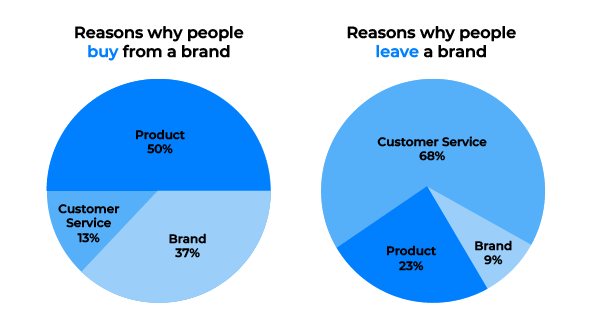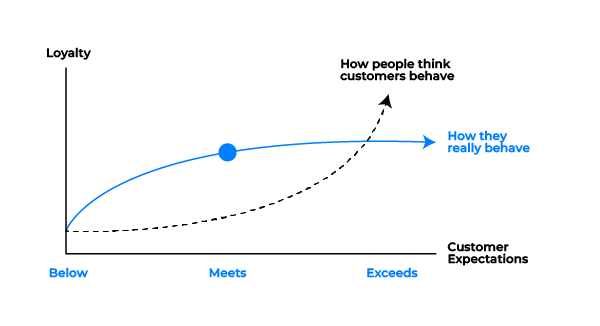- 1. Customers cannot actually be 'loyal' to a brand
- 2. Loyalty is best broken down into two separate buckets
- 3. Poor customer service is the biggest cause of disloyalty (churn)
- 4. Satisfaction and high spending are not indicators of loyalty
- 5. 'Delighting' customers will not get you loyalty gains
- 6. Reducing customer effort is the clearest way to make loyalty gains of all
- How is your customer service department contributing to loyalty?
When you talk to one of our Customer Service Experts, they will probably introduce you to our 'Three Principles of Great Customer Service':
To reduce customer churn: meet customer expectations and solve problems in one friendly conversation.
To build loyalty: continuously reduce your customers' effort throughout their shopping experience.
To optimize customer experience: actively gather and share knowledge about customer needs and expectations across your company.
Rooted in strong, commercial business logic, these principles help team leads manage stakeholder expectations about where customer service should (and shouldn’t) be focusing on. They help identify where service can add the most value. And where it can have a maximum financial impact.
As you might expect, the word loyalty crops up a lot in those principles. Down below are six beliefs we think everyone should know about customer loyalty.
1. Customers cannot actually be 'loyal' to a brand
“From the perspective of consumer psychology, the notion of customer loyalty makes almost no sense” — Philip Graves, author, Consumer.ology
In this report, consumer behavior expert Philip Graves explains that in psychological terms, being loyal is just not something you can apply to humans and brands.
Loyalty is an emotional restraint that keeps humans within the ‘safety of the herd’. When we don’t act in accordance with social ‘rules’, we feel shame and guilt. Without shame and guilt, loyalty cannot exist. And no one should ever really believe that consumers feel so emotionally bad at leaving your brand that they will experience shame and guilt.
So, while customers can indeed keep on using your products, this is not actually ‘loyalty’. Graves believes that repeated use is basically about how good your product is.
All this is worth keeping in mind. The word loyalty will not disappear from the business lexicon any time soon, but it is always good to be clear on what we are actually talking about.
On that note…
2. Loyalty is best broken down into two separate buckets
Most people think of loyalty as one single big thing. But if you are serious about impacting it, and want to employ the right strategies to do that, it is best to think about loyalty in two distinct buckets:
Positive loyalty gains: reasons people stay with your brand
Disloyalty (also called ‘churn’): the reasons people leave your brand
Once you split out loyalty into these two buckets it becomes easier to manage, and communicate about loyalty. It also helps you look at certain claims with a healthy amount of skepticism!
3. Poor customer service is the biggest cause of disloyalty (churn)

Source: Customer Contact Council
While online shoppers buy from you because of your product or brand, they most often leave because of poor customer service.
Yes, it’s true. Customer service is typically the single biggest contributor to brand disloyalty. This is why the most fundamental role of customer service should always be to prevent customers from leaving.
The first priority of your team should be to address speed, friendliness, and effectiveness in meeting customer expectations. Without this in place, your marketing department could be fighting a losing battle.
4. Satisfaction and high spending are not indicators of loyalty
"Between 60 and 80 per cent of customers say they are ‘satisfied’ or ‘very satisfied’… just before leaving" — Harvard Business Review
Many retail brands see customer satisfaction as a great indicator of customer loyalty. But as Frederik F. Reichheld, the inventor of NPS (Net Promoter Score) established himself many years ago, satisfaction is not an indicator of loyalty. This does not mean that satisfaction is unimportant to measure. Satisfaction measures a customer’s attitude towards their latest interaction with your brand — nothing more.
Oh, and your highest-spending customers are probably cheating on you, too. Many retailers believe that a high average spend is an indication of brand loyalty. But as this McKinsey study found, close to half of spending of disposable income by a company’s best customers goes to other retailers in the same category. Meaning: your high-spending customers are not necessarily loyal.
The lesson to take from these examples is:
Correlation is not causation. Be wary of making connections between actually unrelated data
5. 'Delighting' customers will not get you loyalty gains
Exceeding customer expectations will bring you a lot, but probably no increase in loyalty.

Source: Customer Contact Council
Plus, by aiming to ‘delight’, you run the risk of raising expectations for their next interaction with you, which will make them harder to meet! Instead, in service, focus on understanding and meeting basic expectations — this is both tough enough in itself and offers an excellent return on investment.
6. Reducing customer effort is the clearest way to make loyalty gains of all
The bottom line is that, above everything else, customers want their shopping made easier — and customer effort and loyalty benefits are insanely correlated.
The image below shows the differences between customers experiencing low effort throughout the journey vs. those experiencing high effort.

Source: Customer Contact Council
From all the data we have seen, reducing customer effort is the most beneficial thing a retailer can do to meet customer needs — and generate loyalty benefits.
So … think carefully, for example, before redirecting all customers en masse towards self-service and FAQs. That could be killing loyalty at the source.
How is your customer service department contributing to loyalty?
Today, retail brands are facing serious competition. Shopper expectations are still rising. And many brands are still optimizing their mix of bricks and mortar and online and refining their business model and operations as business grows.
In this context, the difference between the cost of acquiring a new customer (versus the cost of making sure existing customers stick around) comes sharply into focus.
With the right tools, you can make sure that customer service plays its full and proper role to maximize its contribution to your company’s growth.
*This article was originally published on robinhq.com
